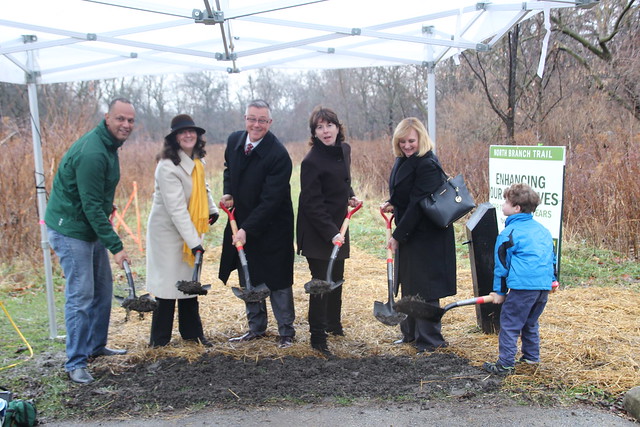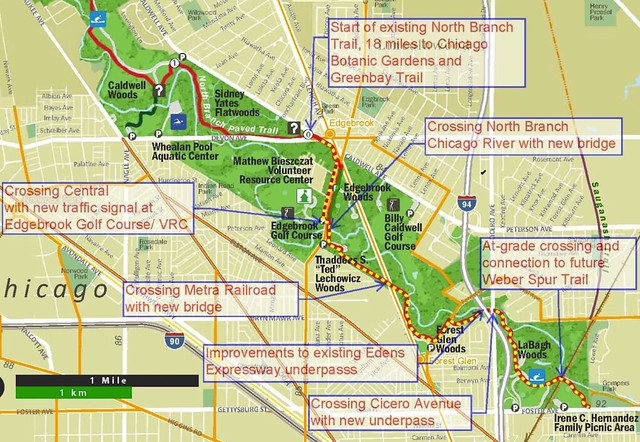
Despite Not In My Back Yard-type opposition from some nearby residents, the Forest Preserves of Cook County is proceeding with plans to extend its popular North Branch Trail three miles further southeast into the city limits. Officials broke ground on the new segment of the path at a ceremony yesterday morning at Thaddeus S. “Ted” Lechowicz Woods, 5901 North Central.
The existing North Branch Trail has Chicago trailheads at Devon/Caldwell and Devon/Milwaukee, near the legendary Superdawg drive-in. It runs 18 miles past the North Branch of the Chicago River and the Skokie Lagoons to the Chicago Botanic Gardens in Glencoe.
The first phase of the construction will build 1.8 miles of paved trail from Devon/Caldwell to Forest Glen, with completion expected this spring. The second stage will add another 1.2 miles, terminating at Gompers Park near FPCC's LaBagh Woods and Irene C. Hernandez Picnic Grove at Foster/Kostner.
“This allows us to eventually connect one of the Forest Preserves’ trails to the city of Chicago’s Lakefront Trail, which has been part of both agencies’ long range plans to bring together two of the region’s best used trails,” FPCC chief Arnold Randall said in a statement.
If the Chicago Department of Transportation follows through with plans to build the Weber Spur Trail, the North Branch extension will connect with it in LaBagh Woods.
The North Branch project will cost about $7.2 million. 80 percent of that comes from federal Congestion Mitigation and Air Quality money and Transportation Alternatives Program funds, administered by the Chicago Metropolitan Agency for Planning. Most of the required 20 percent local match is being funded by FPCC, with $192K coming from Chicago's Open Space Impact Fees program.
“The North Branch Trail Extension will encourage more outdoor activities, boost bicycling and provide a healthy transportation alternative,” said 39th ward alderman Margaret Laurino in a statement. “In addition to the trail being good for the environment, the city money is not coming from taxpayers, but rather from Open Space Impact Fees which are collected from new residential developments to help finance public open space improvements.”
Over the past few years, there have been several public meetings regarding the trail extension where local residents and trail users provided feedback about the project. Many neighbors and members of the bike community have supported the initiative, as have Congressman Mike Quigley, the Illinois Department of Transportation, the Active Transportation Alliance, Trails for Illinois, and the United States Bicycle Route System.
However, there has been opposition from some residents in the surrounding neighborhoods of Old Edgebrook & Indian Woods. They’ve expressed concerns about construction detours and noise, flooding, and the removal of trees – about 450 will be lost.

There have also been concerns over the alignment of the proposed trail route, which has been updated several times due to community feedback. One of the biggest challenges is how to safely route the trail through the high traffic area around the busy Devon/Lehigh/Caldwell/Central intersection.
Most of the motorized traffic runs east-west along Devon Avenue and northwest-southeast along Caldwell Avenue (US Route 14). There is also heavy traffic along Central, which runs through forest preserves south of Devon, with no stoplights until Elston.
All of these roads cross high-traffic railroad tracks used by Metra’s Milwaukee District / North Line, Amtrak and Canadian Pacific freight trains. When a train passes through the area, it adds to the existing congestion.
Many residents have expressed concern about how close the trail will pass through this busy area and especially how it will impact traffic along the busy stretch of Central south of the triangle. The Old Edgebrook subdivision can only be accessed by Louise and Prescott avenues, small streets that intersect with Central.
Some Old Edgebrook residents are worried that it will be difficult to see bicyclists crossing Louise and Prescott on the new sidepath along Central. However, Central already has a sidewalk at these locations, so drivers must already watch for pedestrians crossing at the two locations.
There are also concerns over how the trail will cross over the railroad tracks. Two bridges will be built over the tracks and the river to allow safe crossing.
Residents have also expressed worries about increased crime due to the trail providing a link between their neighborhoods and other Chicago communities. However the existing trail runs already through several different neighborhoods and suburbs, and very few reported crimes have occurred on the path, according to the FPCC.
The forest preserve district should be commended for forging ahead with the project in spite of these NIMBY arguments. The three new miles of multi-use trail will be a great asset for Chicago and surrounding communities.




